Abstract
WC-Co cemented carbides, commonly known as hardmetals, are composite materials constituted by hard ceramic particles embedded in a ductile metal matrix. Due to their unique microstructural assemblage, these materials exhibit excellent combinations of hardness, strength, and toughness, consolidating them as a first choice for tools, structural and wear components. During recent decades, extensive research and technological advancements have driven the development of alternative cemented carbide grades, where traditionally used WC or Co are partially or entirely replaced. Within this context, hardmetals containing a third γ-phase (mixed cubic carbides) represent an interesting alternative. However, accurate evaluation of their fracture toughness remains a significant issue, especially as conventional methods using either indentation or precracking approaches are limited by either restricted implementation of fracture mechanics analysis or testing challenges. Within this context, this study proposes, implements, and validates the use of a novel laser-micronotching methodology to evaluate the fracture toughness of a γ-phase containing cemented carbide grade. For comparison purposes, the investigation also includes assessment of such a property by means of two other well-established testing methodologies. Moreover, similar experimental work was conducted in a plain WC-Co system with similar microstructural features. It is shown that machining of a through-thickness micronotch by means of ultra-short pulsed laser ablation is a reliable and efficient method for fracture toughness evaluation of γ-phase containing hardmetals. The main reason behind this is its capability for providing a precise and reproducible micronotch, with minimal thermal damage, that finally acts as a real through-thickness crack for which a stress-intensity factor is well-defined under flexural testing. Furthermore, toughness values obtained are in satisfactory agreement with those determined using precracked specimens with machined large notches and/or indentation techniques.
1. Introduction
WC-Co cemented carbides, also referred to as hardmetals, exhibit an exceptional combination of mechanical and tribological properties. This has driven their widespread industrial adoption over the past few decades across various applications, including mining, machining and metal forming [,]. Among all the described mechanical properties, fracture toughness plays a critical role in the design and performance of hardmetals, as it directly describes their resistance to brittle fracture under working conditions.
Historically, numerous methodologies have been developed to evaluate fracture toughness in cemented carbide systems, including Palmqvist indentation, Hertzian indentation and conventional fracture mechanics testing protocols employing notched or pre-cracked specimens [,,,]. However, all these techniques often face challenges associated with specimen preparation, particularly in terms of sensitivity to surface finish []. Additionally, some testing methods suffer from inherent experimental difficulties, especially those involving mechanical testing, where the artificial introduction of a notch and/or crack creates a residual stress zone that must be surpassed by the nucleated fissure prior to fracture toughness assessment. This step is very challenging in brittle ceramic compounds []. Due to their complexity, time-intensive nature, and significant machining challenges, notching methodologies with pre-cracked specimens are typically reserved for defining a reference value. It then serves as the baseline for comparison with results determined following faster and simpler testing procedures, such as those based on indentation techniques. Although the latter are commonly simpler, more cost-effective, and less time-consuming than those involving notched/cracked specimens [], the accuracy and reliability of the estimated values are limited to relatively hard and low toughness grades, for which proposed indentation fracture mechanics analysis seems to fit well [,].
As a result, ultrashort pulsed laser ablation (UPLA) has emerged as a promising alternative for shaping shallow notches in testing specimens. This technique has been successfully applied in the surface texturing of hardmetal tools and components [,,]. The advantage of UPLA lies in its ultrafast laser–material interaction, which minimizes the heat transfer to the material substrate, thereby preserving its microstructural integrity while enabling precise and consistent shaping of micronotches (also referred to in this work as μ-notch) []. Several studies have demonstrated that μ-notches created using UPLA in prismatic bars yield fracture toughness values, when subjected to bending up to failure, comparable to those obtained with notched and pre-cracked specimens. This has been validated in materials such as yttria-stabilized zirconia, as well as on various plain WC-Co grades, positioning UPLA μ-notching as a reliable, efficient, and short time-consuming methodology for fracture toughness assessment [].
Within this context and considering the growing adoption of new grades involving alternative carbide and binder combinations—designed to address modern industry demands, raw materials scarcity, health concerns, and environmental challenges (i.e.,) [,,,,], it becomes essential to evaluate and extend the applicability of this methodology to them. Ensuring its effectiveness in such cases adds further complexity, presenting a challenging scenario for achieving a suitable and reliable fracture toughness assessment.
To address the above issues, this study investigated two different hardmetal grades: a standard WC-Co grade and an alternative mixed grade containing γ-phase cubic carbides. Both grades feature comparable microstructural parameters, including grain size and binder content; and thus, binder mean free path. The research aims to evaluate the viability of the UPLA μ-notching for a mixed carbide grade, comparing fracture toughness results with those obtained using more stablished methodologies, using either notched and precracked samples or indentation approaches. Additionally, the influence of γ-phase addition on the material fracture toughness was analyzed. A detailed fractographic inspection of the notched and cracked specimens for both studied grades was performed to assess failure triggering on the basis of observation of failure micromechanisms associated with stable and unstable crack extension.
2. Materials and Methods
2.1. Materials
The experimental hardmetals investigated in this study comprised a γ-phase grade (as (Nb,Ti,W)C carbides) and a standard WC-Co system, both supplied by Hyperion Materials and Technologies. γ-phase containing cemented carbides primarily incorporate additions of TiC, TaC, or NbC. As their concentration exceeds the solubility limit within the metallic binder these carbides precipitate, this leads to the formation of a secondary mixed cubic carbide phase, known as the γ-phase. The morphology of the former typically differs from conventional WC grains, exhibiting a more rounded shape and a distinct coloration [,]. Representative microstructural images of γ-phase containing and standard WC-Co grades are presented in Figure 1.
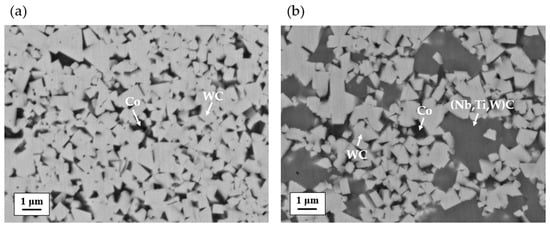
Figure 1.
FESEM micrographs of the investigated hardmetal grades (a) plain WC-Co, and (b) WC-Co-γ systems. γ-phase and WC grains are depicted in dark and light grey respectively, while Co binder appears as black region interspersed among the carbides.
The main microstructural parameters, including grain size (dWC and dγ), binder mean free path (λCo), carbide contiguity (Ccarbide), and cobalt volumetric fraction (%vol Co) are summarized in Table 1. Vickers hardness values are also listed in the table.

Table 1.
Main microstructural parameters and hardness (GPa) of both studied hardmetal grades.
Samples were ground and polished to a mirror-like finish using diamond suspension paste, followed by a final colloidal alumina step. Grain size and binder mean free path were measured using the linear intercept method (LI) on field-emission scanning electron microscope (FESEM) images. To minimize uncertainty, at least 400 measurements were performed for each parameter. Carbide contiguity was also assessed using the LI method, considering all possible intercepted interfaces for each hardmetal grade []. The cobalt volumetric fraction was provided by the supplier. Hardness was evaluated for both materials using a Vickers diamond tip applying a 294 N load. Multiple indentations were performed on each grade to ensure the reliability of the results.
Fracture toughness was evaluated on both mixed and plain cemented carbide grades by means of three different test techniques: indentation fracture toughness (IFT), and using either single edge notched bend (SENB) or single edge μ-notched—shaped by means of ultrashort pulsed laser ablation (UPLA)—bend (SEμNB) specimens. Experimental details for each testing methodology are outlined below. Step-by-step graphical representations of testing procedures using SENB and SEμNB samples are given in Figure 2 and Figure 3, respectively.
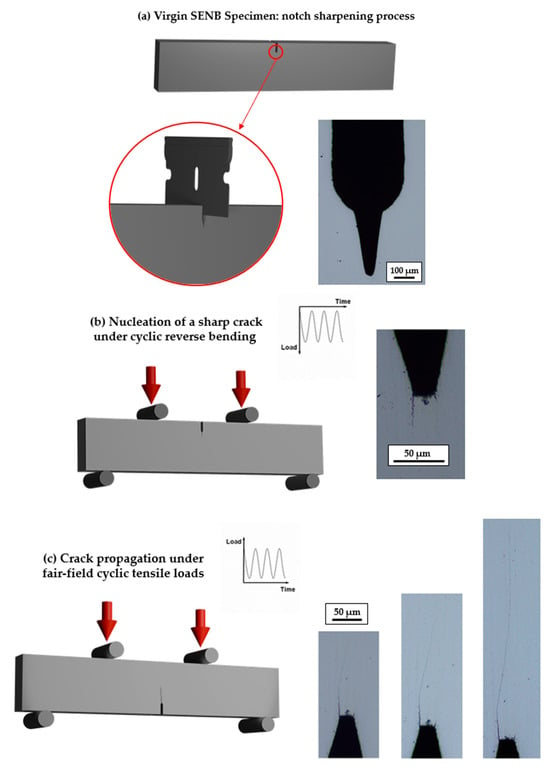
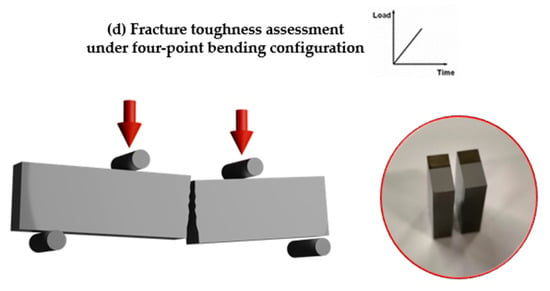
Figure 2.
Schematic representation of step-sequence followed for fracture toughness evaluation using SENB samples: (a) SENB specimen and notch sharpening to achieve a reduced notch tip radius. (b) Crack nucleation through cyclic reverse bending. (c) Stable crack propagation under far-field cyclic tensile loads. Insets show representative OM images of the nucleated crack at different stages. (d) Fracture toughness testing under four-point bending. Macroscopic features of the fractured surface, characterized by the complete absence of plastic deformation, are also presented.
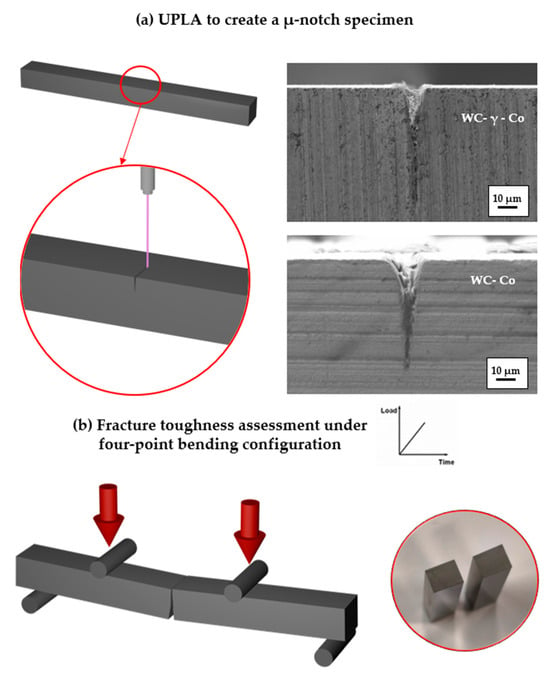
Figure 3.
Schematic representation of step-sequence followed for fracture toughness evaluation using SEμNB samples: (a) Ultrashort pulsed laser ablation (UPLA) technique employed to machine a through-thickness μ-notch with a sharpened tip. Inset displays a FESEM image of the μ-notch profile. (b) Fracture toughness testing under four-point bending. It is also highlighted that laser μ-notch should be located within the inner span (S1). Macroscopic features of the fractured surface, characterized by the complete absence of plastic deformation, are also presented.
2.2. Indentation Fracture Toughness
Indentation fracture toughness (KIc) was estimated using the equation proposed by Shetty et al. []. Surface length of the Palmqvist cracks emanating from the corners of the Vickers indentations (using a 294 N load) were measured and directly related to KIc of the material, according to the following equation (Equation (1)):
where HV is the hardness (N/mm2), P is the applied load (N), L is the average of the length of the cracks at the imprint corners (mm), and β is an empirical constant with value of 8.89 × 10−2. KIc is given as MPa·m1/2.
2.3. SENB Testing Procedure
Fracture toughness was assessed using SENB specimens with dimensions 45 × 10 × 5 mm, with a notch length-to-specimen width ratio (a/W) of 0.4, under four-point bending configuration tests. In doing so, an articulated test jig, with outer and inner spans of 40 and 20 mm, respectively, was employed. Notches were introduced using electrical discharge machining (EDM). Then, a tip sharpening step was performed with a razor blade impregnated with diamond paste to achieve a smaller tip curvature, between 10 and 20 μm (Figure 2a). Sharp crack nucleation at the notch tip was then induced by applying cyclic compressive loads under reverse bending, using the same testing configuration and jig as previously described (Figure 2b). This process employed a sinusoidal waveform at a testing frequency of 10 Hz and a load ratio (R = σmin/σmax) of 10, with maximum compressive stress ranging from 400 to 600 MPa. Cyclic reverse bending tests were run until cracks of approximately 10 μm in length were nucleated [,]. Samples were side-polished to discern crack nucleation phenomena.
Stable crack growth under compression stresses for hardmetals has been extensively reported in the literature [,]. However, tensile residual stresses are intrinsic to the arrested nucleated cracks []. Aiming to get a fissure free of any residual stresses, further crack extension was induced by reversing the pre-cracked specimen and subjecting it to far-field cyclic tensile loads. This was performed using the same load ratio as before, with a sinusoidal waveform and a testing frequency ranging from 0.5 to 5 Hz. Crack growth was monitored using optical microscopy (OM) until an exponential growth rate was achieved, confirming that the propagation occurred in regions free of residual stresses (Figure 2c) [].
Then, fracture toughness using at least three SENB samples was determined by testing the pre-cracked specimens to failure under a constant loading rate of 100 N/s (Figure 2d). In doing so, linear elastic fracture mechanics (LEFM) were implemented using the following equations (Equations (2) and (3)) []:
where a is the crack length, Y is a geometry factor that depends on the configuration of the sample with the notch and the manner in which the loads are applied, α = a/W and β = (1 − α).
Finally, dimension and front uniformity of the crack at the time that unstable failure is triggered was evaluated and validated by FESEM fractographic inspection of broken samples. In doing so, special attention was paid to identify and document failure micromechanisms for both studied grades.
2.4. SEμNB Testing Method
Prismatic SEμNB samples with dimensions 45 × 3 × 4 mm for each grade were used to evaluate fracture toughness with the same four-point bending configuration as described above. Micronotches were generated through material ablation induced by tightly focused ultrashort laser pulses, delivered using a system based on the chirped pulsed amplification technique. The laser system was a Spectra Physics® (Milpitas, CA, USA) one consisting of a Mai Tai oscillator and a Spitfire ACE regenerative amplifier, which provides pulses of duration around 60 fs FWHM, a wavelength of 795 nm, and a repetition rate of 5 kHz [,]. An achromatic doublet from Linos® (Göttingen, Germany) with a focal length of 50 mm focused the laser pulses at normal incidence onto the surface of the samples.
As previously reported for hardmetals [], the selected laser parameters—pulse energy of 4.0 μJ, scanning speed of 500 μm/s, and a total of four passes—were used to achieve the desired notch depth and sharpened notch tip. Same laser parameters were successfully used for shaping through-thickness micronotches in both grades (Figure 3a).
A single notch was introduced into each specimen within the inner span of 20 mm, where maximum tensile stress was applied under the proposed testing configuration. Prior to testing, the longitudinal section subjected to the maximum tensile load was ground and polished for each specimen. Edges were chamfered to prevent potential breakage due to stress concentration effects. At least five SEμNB samples for each grade were tested at a constant loading rate of 100 N/s until failure, using the same universal mechanical unit as before (Figure 3b). Fracture toughness was evaluated using expressions (2) and (3) given above. Notches were observed and measured using FESEM images, before and after mechanical testing, to assess and characterize the notch profile and the affected zone at the notch tip.
3. Results and Discussion
3.1. Comparative Assessment of Methods Used for Fracture Toughness Evaluation
Fracture toughness values obtained for both studied hardmetal grades using the three assessed methodologies—IFT, pre-cracked SENB, and SEμNB—are presented in Table 2. All fracture toughness values listed for SENB and SEμNB specimens were determined based on the effective length of notches and cracks, as measured from FESEM images of broken samples.

Table 2.
Fracture toughness values obtained from the different evaluation methods for the standard WC-Co and the γ -phase containing grades.
Fracture toughness results obtained from the three methodologies showed a satisfactory correlation with data reported in the literature []. First, for a given volume fraction of metallic binder, plain WC-Co grade showed a higher hardness–toughness correlation than the one containing mixed cubic carbides. The reduction in fracture toughness observed in the γ-phase containing grade can be attributed to intrinsic microstructural heterogeneities, particularly the formation of isolated (binderless) agglomerates of cubic carbides, as shown in Figure 1. This isolation arises due to the lower solubility of cubic carbides in the Co liquid phase compared to WC, as well as the stronger interfacial bonding between WC and Co. These phenomena are directly linked to the higher chemical stability of cubic carbides, which reduces their wetting tendency with the metallic binder phase. Lower wetting would result in weaker carbide–Co bonding, diminishing stress transfer and toughening linked to the cobalt binder. Consequently, the heterogeneous distribution of cubic carbides facilitates crack propagation, further lessening fracture toughness [,,,].
Second, IFT values show a trend towards higher values than those determined using pre-cracked SENB specimens. Although this possible overestimation—considering the toughness value measured with notched and precracked samples as baseline—should not be expected for grades whose hardness is above 14 GPa [,], it is known to become more relevant as effective binder content or carbide grain size rise [,]. This indeed applies for the alternative hardmetal grade studied here because the coarser length scale of the mixed carbide as well as the higher effective binder mean free path (Table 1), resulting from the referred heterogenous distribution of the metallic phase. Third, the results obtained from SEμNB specimens exhibited a strong agreement with those from pre-cracked SENB samples for both grades studied. A t-test analysis, conducted at a significance level of α = 0.1, demonstrated that the differences between the fracture toughness values determined by these two methodologies were not statistically significant. This outcome indicates that fracture toughness results obtained using both pre-cracked SENB and SEμNB specimens are equivalent.
The use of UPLA technique generates notches using extremely short high-energy pulses, leading to ultrafast ablation mechanisms that preclude a significant heat transfer to the material bulk. These processes enable effective material removal while ensuring negligible heat-affected zones. Additionally, although shock waves generated during the ablation process may induce localized stress and microstructural modifications, its magnitude is significantly lower—by more than an order of magnitude—compared to those produced by conventional micromachining methods. These stresses dissipate rapidly, typically within few microns, leaving behind a sharp and well-defined micronotch tip free from significant residual stresses. Furthermore, this process ensures a reliable fracture toughness measurement in four-point bending tests of SEμNB specimens with UPLA-generated notches, even in complex cemented carbide systems containing an alternative carbide phase.
Nevertheless, a comprehensive fractographic inspection is essential to ensure consistency and representativeness in notch depth, profile, and crack extension for both pre-cracked SENB specimens and, particularly, SEμNB samples. Furthermore, it is crucial to characterize surface damage, and the overall fractographic features, with particular emphasis on identifying initiation of unstable fracture, where there exists a significant gap in the literature addressing these aspects in mixed carbide systems. This validation will be carried out in the following section using FESEM images of both types of fractured samples.
3.2. Fractographic Inspection
To evaluate the uniformity and length of the cracks and notches, as well as the associated fracture micromechanisms, post-fracture FESEM images were obtained for both pre-cracked SENB and SEμNB specimens.
As illustrated in Figure 4a,b, a relatively consistent notch and crack front is observed in the SENB specimens for both studied materials. A subtle but noticeable contrast, highlighted by the yellow dotted line, separates the regions of stable (existing pre-crack) and unstable fissure propagation.
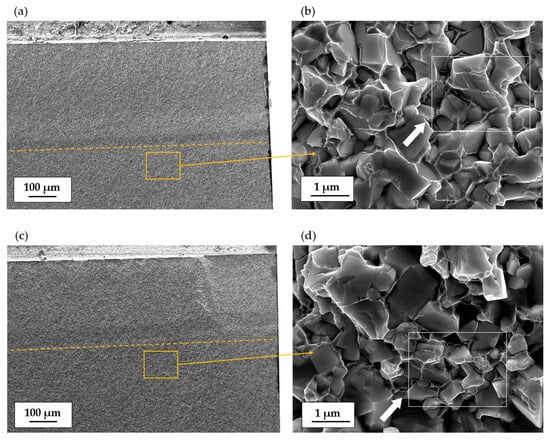
Figure 4.
FESEM images of pre-cracked SENB samples for: (a) WC-Co and (c) WC-γ-Co grades. Both fracture surfaces exhibit similar features, including a distinct top EDM notch region, followed by stable and unstable crack propagation zones, separated by a yellow dotted line. Magnified views of the unstable crack growth areas (below the yellow dotted line) for each cemented carbide are shown in (b,d), respectively. Ductile microcavities within the binder are consistently observed, marking the effective notch length used for fracture toughness calculations.
Relief of the residual stresses introduced during cyclic compression, required stable extension of the nucleated crack under tensile fatigue. As it is well-established in the literature, in cemented carbides such stable crack propagation predominantly occurs within the binder, following a crystallographic step-like path that generates sharp angular facets [,]. This behavior is commonly observed in SENB specimens containing an artificially long through-thickness crack []. In contrast, the failure micromechanism in the unstable crack propagation region is associated with the nucleation and coalescence of ductile microcavities—commonly referred to as dimples—located within the binder. This ductile ligament reinforcement represents the main toughening mechanism in hardmetals [,]. The unstable crack propagation region is further shown in Figure 4c,d, where higher magnification images emphasize the presence of ductile dimple microcavities. For the fracture toughness measurements, effective notch length was determined up to the point where dimple-like behavior was observed in high magnification FESEM images.
A detailed fractographic inspection was also performed on SEμNB specimens, to characterize their fractographic features and establish correlations with the fractographic scenarios observed in pre-cracked SENB specimens. This comparison will further support the fracture toughness measurements obtained for both studied cemented carbide grades with this methodology. Low magnification FESEM images shown in Figure 5 and Figure 6 present the notch fracture surface for the γ-phase containing cemented carbide and the plain WC-Co system, respectively. A uniform notch profile was observed throughout the entire thickness of all tested specimens, with notch depths ranging from 50 to 60 μm.
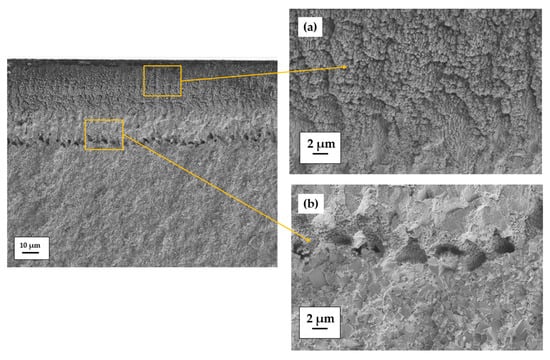
Figure 5.
Low magnification FESEM fractography image of SEμNB notch for WC-γ-Co grade. The notch profile and depth are uniform throughout the specimen thickness. Two distinct regions are identified: (a) geometrical notch created by laser ablation, and (b) the small, damaged region located ahead of the laser notch tip.
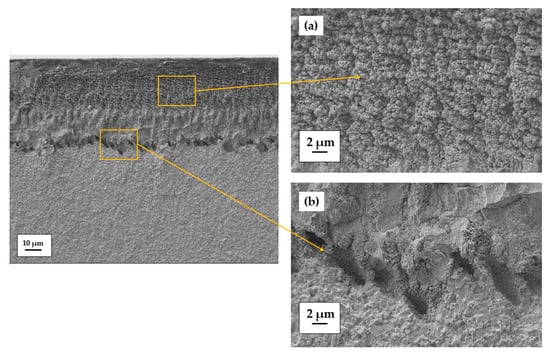
Figure 6.
Low magnification FESEM fractography image of SEμNB notch for plain WC-Co grade. The notch profile and depth are uniform throughout the specimen thickness. The same two distinct regions previously described for the WC-γ-Co grade are observed: (a) geometrical notch created by laser ablation, and (b) the small, damaged region located ahead of the laser notch tip.
For the γ-phase containing cemented carbide, two distinct zones were evidenced on the fracture surface of the UPLA laser notch, both resulting from the direct or indirect interaction between the laser and the specimens. High magnification images of these zones are shown in Figure 5a,b for the γ-phase cemented carbide grade. Figure 5a depicts the geometrical notch generated by UPLA, where the observed pattern corresponds to material ablation. In Figure 5b, the pre-damaged zone ahead of the crack tip is highlighted, characterized by the small-scale interactions of interconnected microcracks induced during the process [,,]. This fractographic pattern is also identified in the reference WC-Co grade, as shown in Figure 6, underscoring the consistency between the reference cemented carbide and γ-phase containing grade.
A direct transition is observed between the pre-damaged zone and a well-defined region characterized by the presence of dimples within the binder in both samples. This finding establishes a clear correlation between the fractographic features observed in both pre-cracked SENB and SEμNB specimens, marking the onset of the unstable failure zone. It further confirms that the same fractographic and measurement scenarios are applicable to both methodologies. This feature is illustrated in Figure 7 for both studied cemented carbide grades, providing strong evidence for the validity of the UPLA μ-notching technique as a reliable and consistent method to evaluate fracture toughness in plain and γ-phase containing cemented carbide systems.

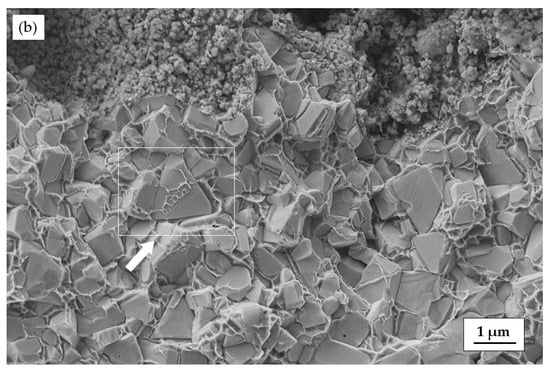
Figure 7.
FESEM images showing the boundary between the pre-damaged zone at the notch tip and the unstable failure zone for: (a) WC-γ-Co and (b) WC-Co grades, respectively. Ductile dimples observed in both grades are indicated with arrows in the regions highlighted by the drawn rectangles.
4. Conclusions
This study investigated the reliability of using UPLA μ-notched specimens in conjunction with four-point bending tests as a time- and cost-effective alternative for assessing the fracture toughness of cemented carbides, compared to the conventional testing of pre-cracked SENB specimens. Particular emphasis was placed on evaluating the viability of the proposed methodology for calculating the fracture toughness of a γ-phase containing cemented carbide system. Based on the results obtained, the following conclusions can be drawn:
- (1)
- The UPLA laser μ-notching technique, combined with flexural testing, is a reliable and efficient method for evaluating fracture toughness in cemented carbides. It produces sharp, well-defined notches with minimal residual stresses, ensuring accuracy comparable to pre-cracked SENB specimens, while providing a faster and simpler fracture toughness measurement.
- (2)
- Fracture toughness values obtained from SEμNB specimens were statistically equivalent to those measured with SENB specimens, as confirmed by t-test analysis. This result validates the use of UPLA-generated notches for accurate toughness evaluation, including in γ-phase containing cemented carbide grades.
- (3)
- The fractographic analysis revealed consistent failure micromechanisms between SEμNB and pre-cracked SENB specimens. Ductile dimples observed ahead of the laser μ-notch were also found in pre-cracked SENB specimens, ahead of the crack tip. Moreover, consistency in laser notch profile and depth was evidenced across both studied materials. These findings further validate the applicability of UPLA μ-notching as a viable and reproducible technique to assess fracture toughness in both plain WC-Co and γ-phase cemented carbide grades.
Based on the findings of this study, future work should focus on extending the proposed testing methodology to other cemented carbide grades, including both γ-phase containing and plain WC-Co systems with varying microstructural features, such as a higher binder volume fraction and larger grain sizes. This would help determine whether the methodology can be effectively applied to tougher grades, offering a fast and reliable alternative to the IFT method, which is known to overestimate fracture toughness above a certain threshold. Additionally, an in-depth characterization of potential microstructural changes induced by laser ablation using advanced characterization techniques, such as electron back scatter diffraction (EBSD) or transmission electron microscopy (TEM), could be explored. Finally, the feasibility of creating short, shallow, and through-thickness μ-notches via the UPLA technique could be investigated as a potential alternative to conventional SENB pre-cracking methods for FCG testing, providing a faster and more efficient way to prepare viable test specimens.
Author Contributions
Conceptualization M.S. and L.L.; methodology M.S. and L.L.; investigation and formal analysis M.S. and R.B.; Resources P.M., N.C. and E.T.; writing—original draft preparation M.S.; writing—review and editing N.C., E.T., P.M., E.J.-P. and L.L. All authors have read and agreed to the published version of the manuscript.
Funding
This research was partly supported by the Spanish Government (Ministerio de Ciencia, Innovación y Universidades and Agencia Estatal de Investigación) and European Union (FEDER) through the projects PID2021-126614OB-I00, PID2022-137274NB-C32, and PID2023-150637OB-I00, and it is part of the María de Maeztu grant CEX2023-001300-M, all of them funded by MICIU/AEI/10.13039/501100011033.
Data Availability Statement
Data are contained within the article.
Acknowledgments
The research work was conducted within an Industry-Academy collaboration between Hyperion Materials & Technologies and Universitat Politècnica de Catalunya.
Conflicts of Interest
The authors declare no conflicts of interest.
References
- Prakash, L. Fundamentals and General Applications of Hardmetals. In Comprehensive Hard Materials; Elsevier Ltd.: Amsterdam, The Netherlands, 2014; pp. 29–90. [Google Scholar] [CrossRef]
- García, J.; Collado-Ciprés, V.; Blomqvist, A.; Kaplan, B. Cemented carbide microstructures: A review. Int. J. Refract. Met. Hard Mater. 2019, 80, 40–68. [Google Scholar] [CrossRef]
- Viswanadham, R.K.; Sun, T.S.; Drake, E.F.; Peck, J.A. Quantitative fractography of WC-Co cermets by Auger spectroscopy. J. Mater. Sci. 1981, 16, 1029–1038. [Google Scholar] [CrossRef]
- Pickens, J.R.; Gurland, J. The fracture toughness of WC-Co alloys measured on single-edge notched beam specimens precracked by electron discharge machining. Mater. Sci. Eng. 1978, 33, 135–142. [Google Scholar] [CrossRef]
- Warren, P.D. Determining the fracture toughness of brittle materials by Hertzian indentation. J. Eur. Ceram. Soc. 1995, 15, 201–207. [Google Scholar] [CrossRef]
- Torres, Y.; Casellas, D.; Anglada, M.; Llanes, L. Fracture toughness evaluation of hardmetals: Influence of testing procedure. Int. J. Refract. Met. Hard Mater. 2001, 19, 27–34. [Google Scholar] [CrossRef]
- Kenny, P. The application of fracture mechanics to cemented carbides. Powder Met. 1971, 14, 22–38. [Google Scholar] [CrossRef]
- Sheikh, S.; M’Saoubi, R.; Flasar, P.; Schwind, M.; Persson, T.; Yang, J.; Llanes, L. Fracture toughness of cemented carbides: Testing method and microstructural effects. Int. J. Refract. Met. Hard Mater. 2015, 49, 153–160. [Google Scholar] [CrossRef]
- Chychko, A.; García, J.; Collado-Ciprés, V.; Holmström, E.; Blomqvist, A. HV-K Ic property charts of cemented carbides: A comprehensive data collection. Int. J. Refract. Met. Hard Mater. 2022, 103, 105763. [Google Scholar] [CrossRef]
- Shetty, D.K.; Wright, I.G.; Mincer, P.N.; Clauer, A.H. Indentation fracture of WC-Co cermets. J. Mater. Sci. 1985, 20, 1873–1882. [Google Scholar] [CrossRef]
- Fang, S.; Klein, S.; Bähre, D.; Llanes, L. Performance of laser surface textured cemented carbide tools during abrasive machining: Coating effects, surface integrity assessment and wear characterization. CIRP J. Manuf. Sci. Technol. 2020, 31, 130–139. [Google Scholar] [CrossRef]
- Hajri, M.; Börner, P.; Wegener, K. An industry-relevant method to determine material-specific parameters for ultra-short pulsed laser ablation of cemented carbide. Procedia CIRP 2018, 74, 709–713. [Google Scholar] [CrossRef]
- Turon-Vinas, M.; Morillas, J.; Moreno, P.; Anglada, M. Evaluation of damage in front of starting notches induced by ultra-short pulsed laser ablation for the determination of fracture toughness in zirconia. J. Eur. Ceram. Soc. 2017, 37, 5127–5131. [Google Scholar] [CrossRef]
- Ortiz-Membrado, L.; Liu, C.; Prada-Rodrigo, J.; Jiménez-Piqué, E.; Lin, L.L.; Moreno, P.; Wang, M.S.; Llanes, L. Assessment of fracture toughness of cemented carbides by using a shallow notch produced by ultrashort pulsed laser ablation, and a comparative study with tests employing precracked specimens. Int. J. Refract. Met. Hard Mater. 2022, 108, 105949. [Google Scholar] [CrossRef]
- Hearing, B.; Gestrich, T.; Steinborn, C.; Vornberger, A.; Pötschke, J. Influence of alternative hard and binder phase compositions in hardmetals on thermophysical and mechanical properties. Metals 2023, 13, 1803. [Google Scholar] [CrossRef]
- de Nicolás, M.; Besharatloo, H.; Alvaredo, P.; Roa, J.J.; Llanes, L.; Gordo, E. Design of alternative binders for hard materials. Int. J. Refract. Met. Hard Mater. 2020, 87, 105089. [Google Scholar] [CrossRef]
- Soria-Biurrun, T.; Navarrete-Cuadrado, J.; Lozada-Cabezas, L.; Ibarreta-Lopez, F.; Martínez-Pampliega, R.; Sánchez-Moreno, J.M. Microstructure, mechanical properties and fracture behavior of NiCoCrTiAl and FeNiCoCr new alternative binders for WC based hardmetals. Int. J. Refract. Met. Hard Mater. 2021, 103, 105748. [Google Scholar] [CrossRef]
- Grilli, M.L.; Bellezze, T.; Gamsjäger, E.; Rinaldi, A.; Novak, P.; Balos, S.; Piticescu, R.R.; Ruello, M.L. Solutions for critical raw materials under extreme conditions: A review. Materials 2017, 10, 285. [Google Scholar] [CrossRef]
- von Spalden, M.; Pötschke, J.; Michaelis, A. Novel alternative Ni-based binder systems for hardmetals. Crystals 2024, 14, 1013. [Google Scholar] [CrossRef]
- Exner, H.E. Physical and Chemical Nature of Cemented Carbides. Int. Met. Rev. 1979, 24, 149–173. [Google Scholar] [CrossRef]
- Roebuck, B.; Almond, E.A. Deformation and fracture processes and the physical metallurgy of WC–Co hardmetals. Int. Mater. Rev. 1988, 33, 90–112. [Google Scholar] [CrossRef]
- Torres, Y.; Anglada, M.; Llanes, L. Fatigue mechanics of WC–Co cemented carbides. Int. J. Refract. Met. Hard Mater. 2001, 19, 341–348. [Google Scholar] [CrossRef]
- Iizuka, H.; Tanaka, M. Fracture toughness measurement with fatigue-precracked single edge-notched beam specimens of WC-Co hard metall. J. Mater. Sci. 1991, 26, 4394–4398. [Google Scholar] [CrossRef]
- Suresh, S. The failure of hard materials in cyclic compression: Theory, experiments and applications. Mater. Sci. Eng. A 1988, 105, 323–329. [Google Scholar] [CrossRef]
- James, M.N.; Human, A.M.; Luyckx, S. Fracture toughness testing of hard metals using compression-compression precracking. J. Mater. Sci. 1990, 25, 4810–4814. [Google Scholar] [CrossRef]
- Godse, R.; Gurland, J.; Suresh, S. Effects of residual stresses in fracture toughness testing of hard metals. Mater. Sci. Eng. A 1988, 105, 383–387. [Google Scholar] [CrossRef]
- Munz, D.; Fett, T.; Properties, M.; Behaviour, F.; Selection, M. Ceramics; Springer: Berlin/Heidelberg, Germany, 1999. [Google Scholar] [CrossRef]
- Melk, L.; Turon-Vinas, M.; Roa, J.J.; Antti, M.-L.; Anglada, M. The influence of unshielded small cracks in the fracture toughness of yttria and of ceria stabilised zirconia. J. Eur. Ceram. Soc. 2016, 36, 147–153. [Google Scholar] [CrossRef]
- Turon-Vinas, M.; Anglada, M. Assessment in Si3N4 of a new method for determining the fracture toughness from a surface notch micro-machined by ultra-short pulsed laser ablation. J. Eur. Ceram. Soc. 2015, 35, 1737–1741. [Google Scholar] [CrossRef]
- Konyashin, I.; Ries, B.; Carbides, C. Cemented Carbides; Elsevier: Amsterdam, The Netherlands, 2022. [Google Scholar] [CrossRef]
- Huang, S.G.; Liu, C.; Liu, B.L.; Vleugels, J.; Huang, J.H.; Lauwers, B.; Qian, J.; Mohrbacher, H. Microstructure and mechanical properties of (Nb,W,Ti)(C,N)-Ni solid solution cermets with 6 to 20 wt% Ni. Int. J. Refract. Met. Hard Mater. 2022, 103, 105757. [Google Scholar] [CrossRef]
- Li, N.; Zhang, W.; Peng, Y.; Du, Y. Effect of the cubic phase distribution on ultrafine WC–10Co–0.5Cr–xTa cemented carbide. J. Am. Ceram. Soc. 2015, 99, 1047–1054. [Google Scholar] [CrossRef]
- Ramqvist, L. Preparation, properties and electronic structure of refractory carbides and related compounds. Jernkontoret Ann. 1969, 153, 159–179. [Google Scholar]
- Schleinkofer, U.; Sockel, H.G.; Görting, K.; Heinrich, W. Microstructural processes during subcritical crack growth in hard metals and cermets under cyclic loads. Mater. Sci. Eng. A 1996, 209, 103–110. [Google Scholar] [CrossRef]
- Llanes, L. In-depth understanding of fatigue micromechanisms in cemented carbides: Implications for optimal microstructural tailoring. Metals 2019, 9, 924. [Google Scholar] [CrossRef]
- Serra, M.; García-Marro, F.; Cinca, N.; Tarrés, E.; Jiménez-Piqué, E.; Llanes, L. Finite fatigue life behavior and fatigue crack-growth resistance of a fine-grained WC-Co cemented carbide. Int. J. Refract. Met. Hard Mater. 2025, 128, 107022. [Google Scholar] [CrossRef]
- Sigl, L.S.; Fischmeister, H.F. On the fracture toughness of cemented carbides. Acta Met. 1988, 36, 887–897. [Google Scholar] [CrossRef]
- Torres, Y.; Tarrago, J.M.; Coureaux, D.; Tarrés, E.; Roebuck, B.; Chan, P.; James, M.; Liang, B.; Tillman, M.; Viswanadham, R.K.; et al. Fracture and fatigue of rock bit cemented carbides: Mechanics and mechanisms of crack growth resistance under monotonic and cyclic loading. Int. J. Refract. Met. Hard Mater. 2014, 45, 179–188. [Google Scholar] [CrossRef]
Disclaimer/Publisher’s Note: The statements, opinions and data contained in all publications are solely those of the individual author(s) and contributor(s) and not of MDPI and/or the editor(s). MDPI and/or the editor(s) disclaim responsibility for any injury to people or property resulting from any ideas, methods, instructions or products referred to in the content. |
© 2025 by the authors. Licensee MDPI, Basel, Switzerland. This article is an open access article distributed under the terms and conditions of the Creative Commons Attribution (CC BY) license (https://creativecommons.org/licenses/by/4.0/).